July 28, 2023
Air Date: July 28, 2023
FULL SHOW
SEGMENTS
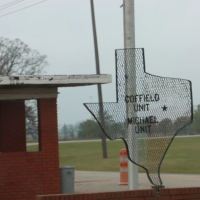
Overheated in Prison
View the page for this story
The summer of 2023 has seen record temperatures and extreme heat waves that can be particularly dangerous for prison inmates without access to air conditioning. Texas Public Radio’s Paul Flahive tells the story of overheated prisoners in Texas. (04:42)
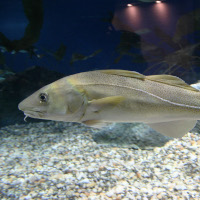
Beyond the Headlines
/ Peter DykstraView the page for this story
In this week’s trip beyond the headlines, Living on Earth contributor Peter Dykstra joins host Steve Curwood to discuss the ways in which Iceland is repurposing the waste from fish catch, from skin grafts to pharmaceuticals. Then, the two take a look at the string of homes being built in North Carolina’s floodplains seemingly incentivized by the state’s flood buyout program. Finally, for history the pair discuss the life of Kenneth Bainbridge, who directed the first successful test of the atom bomb. (05:25)

Note on Emerging Science: Glass Frogs
/ Don LymanView the page for this story
So-called glass frogs have translucent skin, which shows their internal organs. Living on Earth’s Don Lyman reports that these frogs have a special kind of blood that helps them camouflage when sleeping. (01:34)

The UAE Boosts Climate Pledge
View the page for this story
The UAE has increased its climate ambition targets under the Paris Agreement following criticism around their choice of a top oil executive to lead this year’s UN climate talks. But researchers claim the UAE is unlikely to meet its climate targets given its plans to boost oil and gas production. David Tong, the Global Industry Campaign Manager for Oil Change International, joins host Aynsley O’Neill to explain what the UAE policy means for COP28. (07:16)
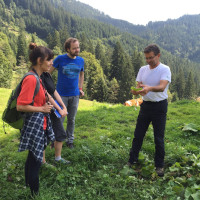
Europe Votes to Restore Nature
View the page for this story
To address the main causes of biodiversity loss, the European Union Parliament has approved a nature restoration plan, designed to restore at-risk ecosystems like wetlands. The goal is to conserve 30% of EU territory by 2030. Inside Climate News reporter Bob Berwyn joins host Aynsley O’Neill to discuss. (07:33)
Slip-Sliding Away
/ Mark Seth LenderView the page for this story
River otters tend to avoid human contact, but Living on Earth’s Explorer-in-Residence Mark Seth Lender shares a once-in-a-lifetime encounter with the elusive creatures. (05:22)
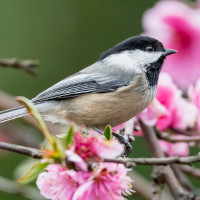
BIRIDNOTE®: Bird Habitat at Home
/ Ariana RemmelView the page for this story
Cultivating natural habitat for native birds can help combat biodiversity loss, as Ariana Remmel reports in today’s BirdNote. (02:02)

Mining Riches on the Ocean Floor
View the page for this story
In the depths of the sea, parts of the ocean floor are covered with manganese nodules. These contain valuable minerals that could be extremely useful for renewable energy resources, like electric car batteries. But mining these nodules could prove hazardous for deep ocean biodiversity, Professor Eugene Gallagher from the University of Massachusetts Boston explains to host Steve Curwood. (11:15)
Show Credits and Funders
Show Transcript
230728 Transcript
HOSTS: Steve Curwood
GUESTS: Bob Berwyn, Eugene Gallagher, David Tong
REPORTERS: Peter Dykstra, Paul Flahive, Mark Seth Lender, Don Lyman, Ariana Remmel
[THEME]
CURWOOD: From PRX – this is Living On Earth.
[THEME]
CURWOOD: I’m Steve Curwood.
O’NEILL: And I’m Aynsley O’Neill.
The European Union advances an ambitious nature restoration law.
BERWYN: The EU itself estimates that about 80% of its natural areas are not in good shape. Some of the main proponents have said “yeah nature is amazing, and it has the capacity to really heal itself but we’re hammering it and it’s time to reverse that.
CURWOOD: Also, deep sea mining could threaten biodiversity on the ocean floor.
GALLAGHER: I was doing a back of the envelope calculation, and you’ve got an area about the size of the southern part of the entire United States and the entire area that’s been quantitatively sampled, with the species identified, would fit in a one quarter of a basketball court.
CURWOOD: Those stories and more this week on Living on Earth – Stick Around!
[NEWSBREAK MUSIC: Boards Of Canada “Zoetrope” from “In A Beautiful Place Out In The Country” (Warp Records 2000)]
Overheated in Prison

The Coffield Unit, a Texas prison that can house over 4,000 inmates, is located two hours east of Waco in unincorporated Anderson County. (Photo: Paul Flahive, Texas Public Radio)
CURWOOD: From PRX and the Jennifer and Ted Stanley Studios at the University of Massachusetts Boston, this is Living on Earth. I’m Steve Curwood.
O’NEILL: And I’m Aynsley O’Neill.
Around the world, record breaking heat waves have sparked a new round of climate chaos, from heat advisories to severe flooding. And starting around July 24th in Algeria, wildfires. Nearly 100 blazes have caused dozens of deaths and forced thousands of evacuations.
DEUTSCHE WELLE REPORTER: The extreme heat and high winds have made it harder for emergency crews to contain them. As flames burnt into the night, an orange glow shrouded the mountainous Kabyle region. Fires spread to residential areas, sweeping through several villages. Much of Algeria’s northern provinces have been torched. Homes, trees, and land left in ashes.
O’NEILL: Closer to home, Texas has been seeing heatwaves push temperatures over 110 degrees Fahrenheit. This is proving especially dangerous for the often-forgotten population of prisoners. More than two-thirds of the state’s prisons lack air conditioning, leaving around 100,000 inmates unable to keep cool in the summers. The Texas Department of Criminal Justice maintains that there have been no heat-related deaths in state-run prisons since 2012, but independent groups say otherwise. A 2022 study led by Brown University found 271 deaths tied to a lack of air conditioning in Texan prisons between the years of 2001 and 2019. And with the Summer of 2023 seeing heat wave after heat wave in much of the state, eyes are turning towards the vulnerable prison population of Texas. From San Antonio, Texas Public Radio’s Paul Flahive has the story.
FLAHIVE: This Texas inmate says the best way to describe what it's like to be in a Texas prison cell without air conditioning is to think barbecue.
INMATE: Like you're standing over a grill all day.
FLAHIVE: "It's like standing over a grill all day." We aren't using this inmate's name because Texas prison rules bar him from giving phone interviews, and he worries about retribution from administrators. He says he goes to bed drenched in sweat every night and wakes up drenched every day. In between he tries to stay cool by dousing himself in water.

June 2023 temperature readings of Texas Department of Criminal Justice facilities. Yellow indicates facilities that felt temperatures over 85 degrees Fahrenheit, orange indicates temperatures over 90 degrees, and red is for temperatures over 100 degrees. (Photo: Courtesy of Texas Department of Criminal Justice. Color Coding by TPR.)
INMATE: The lowest you are, the cooler it is. So I put I put water on my ground. I lay in it sometimes. It's just me pretty much naked in the cell.
FLAHIVE: Data from the Texas Department of Criminal Justice obtained from a state lawmaker show its 68 prisons without air conditioning were sweltering last month, averaging well over 85 degrees. That would be a safety violation for a county jail, that mandates temperatures remain below 85. But no such regulation exists for state prisons, some of which reached as high as 106 degrees last month. And those readings weren't taken at the height of the facilities' heat. Heat estimates are as high as 115 degrees.
ALDACO: You know it's hot, it's hot.
FLAHIVE: Don Aldaco spent 14 years in unairconditioned prisons across Texas. He was paroled in April. Aldaco says he was lucky to get three hours of sleep a night on the hottest days.
ALDACO: Sometimes I wake up in the middle of the night where I'm pouring sweat. You know, I'm pouring sweat, but I'm thinking that I've got something crawling on me. But it's the actual sweat pouring off your body.
FLAHIVE: Aldaco says he's lucky to get three hours of sleep a night on the hottest days. A spokeswoman for the state prison system says they take special precautions for heat sensitive inmates, keeping them in air-conditioned beds. For everyone else, they offer limited access to respite or air-conditioned areas, and when possible, offer additional showers, ice, and allow for personal fans. But the inmate in the north Texas prison we spoke with says those efforts aren't enough, and he says correction officers blame an ongoing staffing crisis.

This graphic shows state prisons in relation to temperature, and marked with color-coded indicators as to their air conditioning status. (Photo: Texas Public Radio)
INMATE: Their excuse for everything is the staff. People that got the staff, we're not getting showers. You might get a shower once or twice a week. You might go to break once or twice a week. You get cold water once or twice a day, and their excuse always is: the staff, staff, staff.
FLAHIVE: The inmate says he's concerned about his health. A 2022 study by the Journal of the American Medical Association found 271 prisoner deaths in Texas facilities without air conditioning between 2001 and 2019 may be attributable to extreme heat days.
MOODY: I think it is very well documented that the heat has contributed to deaths in this prison system.
FLAHIVE: Texas State House member Joe Moody, a Democrat, has for years tried to pass legislation to air condition all state prisons.
MOODY: There's no need for us to continue to allow folks to cook, literally cook, in our prisons. And that's, that's something we should we should just always find unacceptable.
FLAHIVE: House Rep Moody's bill again failed. Then the Republican-dominated state Senate stripped $500 million out of the budget bill that would have dramatically increased air conditioning in prisons throughout the system. For Living on Earth, I'm Paul Flahive.
Related links:
- Learn more on Texas Public Radio’s webpage
- Learn more about reporter Paul Flahive
- Brown University | “Extreme Temperatures Take Deadly Toll on People in Texas Prisons, Study Finds”
[MUSIC: Alfa Mist, “Brain” on Antiphon, Sekito]
Beyond the Headlines
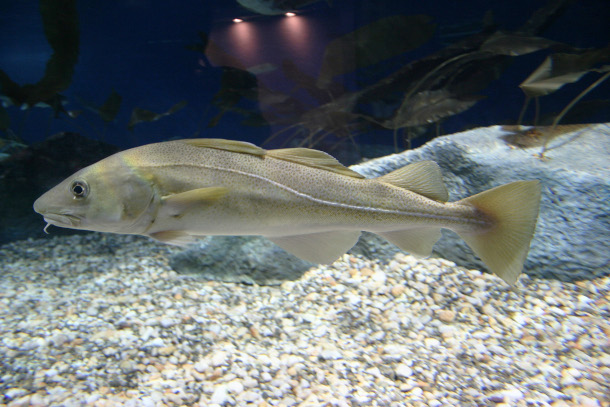
In Iceland, waste from the seafood industry is being repurposed in leather, blood-clotting agents, and collagen supplements. Skin from the Atlantic cod (shown above) has even been used in human skin grafts. (Photo: The Maritime Aquarium at Norwalk, Flickr, CC BY-ND 2.0)
CURWOOD: On the line now from Atlanta, Georgia, is Peter Dykstra, contributor to Living on Earth, with fascinating stories beyond the headlines. Hey, Peter, what do you have for us today?
DYKSTRA: Hi, Steve. We'll go to Iceland, where their longstanding traditional economy of fishing and tourism may be getting a boost, because efforts are underway to see that all that fish waste goes to a second life. Icelanders have found a way to use skin from codfish as a replacement for human skin in severe burn victims.
CURWOOD: Wait, Peter, you're saying that they're using fish for skin grafts on people, it sounds like.
DYKSTRA: Yeah, and they say it looks a little like fish skin, but it can be a godsend to people who have those severe burns. They cite an electrocution victim, much of whose torso was compromised, who's now walking around in a cod skin. Moreover, for the business side of this, the company that's invented this new way to use cod waste just sold for over a billion dollars.
CURWOOD: That's pretty amazing. And of course, you know, you think of fish waste just, what? Being made into meal for pets or something like that. But this sounds like a lot more ambition.
DYKSTRA: Or thrown out just as something kind of smelly. Fish like Atlantic salmon are being reprocessed into leather for high fashion industry. And chitosan, that shell that some crustaceans like shrimp are encased in, are used and transformed into a blood-clotting agent.
CURWOOD: Right, rather efficient, I would say.
DYKSTRA: E-FISH-ent. Nice.
CURWOOD: Hey, what else do you have for us?
DYKSTRA: Here's one that's not quite so efficient. In the state of North Carolina, the University of North Carolina studied the flood buyout program, where the state offers to buy properties that are in harm's way from floods. They've bought about 5000 such homes, but they've apparently let about 10 times as many new homes be built in floodplains. That's sort of taking a solution and replacing it with a bigger problem.
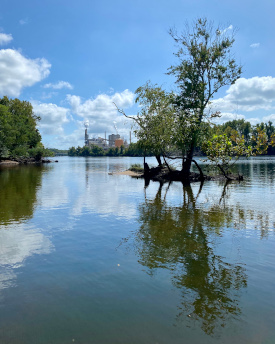
A study finds that, for every flood-prone house bought out by the North Carolina government from 1996 to 2017, 10 more were built in a floodplain. (Photo: Matt Walter, Flickr, CC BY-SA 2.0)
CURWOOD: Well, because people know that, hey, if they build a house, the state will come and buy it out if they get flooded out.
DYKSTRA: That's right. That's not just a problem in North Carolina. It's a problem everywhere, particularly in coastal areas, that promises only to get worse as sea level rise and more frequent storms, two of the calling cards of global warming, come to claim more coastal properties.
CURWOOD: Peter, that story reminds me that many in the media have not really paid a whole lot of attention to the risks and consequences of climate change. How much do you think that's changing these days, with the extreme weather?
DYKSTRA: It's changing. It's changing as much as someone like you or me would have liked to have seen it change 20 and 30 years ago. There's a big 'I told you so' to be said by environmental journalists who were, no pun intended, blown off for years, to see that the mainstream media is finally noticing these deluges, these atmospheric rivers causing unprecedented floods, unprecedented wildfires, unprecedented storms, everywhere, not just in the United States, but throughout the world. We knew it was going to happen everywhere. And even if people are listening way too late, it's better than not listening at all.
CURWOOD: Well, and it's not too late to do something, because it's just going to keep getting worse if we don't make a change. Hey, what do you have from the annals of history for us today?
DYKSTRA: We'll go back to July 27th, 1904. One of the key people to ushering in the Atomic Age, Kenneth Bainbridge, was born. He actually led the project under Oppenheimer and General Leslie Groves to build and detonate the first atomic bomb, which also happened in the month of July, back in 1945.
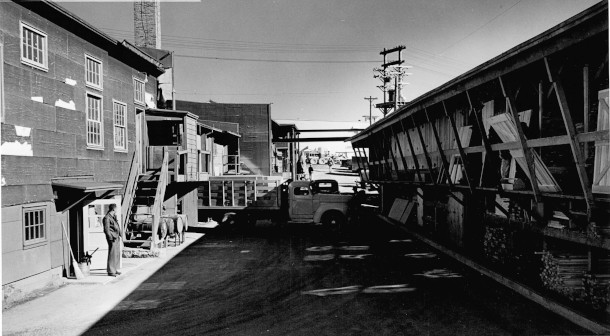
July 27, 2023, would have been the 119th birthday of Kenneth Bainbridge, a physicist in charge of the first detonation of an atomic bomb. That explosion, codenamed “Trinity,” took place south of Los Alamos, New Mexico. Above, a maintenance area at Los Alamos National Laboratory. (Photo: United States Department of Energy, Wikimedia Commons, public domain)
CURWOOD: Yes, and I met Professor Bainbridge in a freshman seminar when I was a student at Harvard. They offered a nuclear physics seminar, and, actually, he did show us about cyclotrons, and I did learn some nuclear physics. In fact, I use it in this work. But he spent most of the time saying he had a lot of regrets about that so-called "Manhattan Project," developing and exploding the nuclear bombs. And, famously, he said to Oppenheimer, when they had the first very successful test, that now we are all sons of bitches.
DYKSTRA: That's right. And Oppenheimer had those same regrets.
CURWOOD: And it's a reminder, and Professor Bainbridge made this clear, it's a reminder that any technology that we develop as scientists, we need to think about what the social implications are. It's not just abstract science, it will have an impact on people.
DYKSTRA: That's right.
CURWOOD: Well, thanks, Peter. Peter Dykstra is a regular contributor to Living on Earth. And we'll talk to you again real soon.
DYKSTRA: All right, Steve. Thanks a lot, and we'll talk to you soon.
CURWOOD: And there's more on these stories at the Living on Earth webpage. That's loe.org.
Related links:
- Read about efforts in Iceland to repurpose fish waste
- Check out the North Carolina floodplain study
- Learn more about Kenneth Bainbridge
[MUSIC: Reuben James, Conor Albert, Soweta Kinch “Ruby Smiles” on Tunnel Vision, Rufio Records]
O’NEILL: Just ahead, Europe takes a major step towards combatting biodiversity loss with a nature restoration plan. But first, this note on emerging science from Don Lyman.
[SCIENCE NOTE THEME]
Note on Emerging Science: Glass Frogs

A glass frog (Rulyrana susatamai) sits on a leaf. (Photo: Mauricio Rivera Correa, Wikimedia Commons, CC BY-SA 2.5)
LYMAN: Glass frogs are a tropical species whose name derives from their translucent skin, which is clear enough to see through to their internal organs and their blood circulating. And scientists have recently discovered that when the tiny frogs sleep in the rainforest at night, 90 percent of their red blood cells disappear into their liver, which hides the cells behind a mirror-like surface. That makes them more camouflaged and harder to spot for hungry predators, like snakes.
Scientists were surprised to find out that, despite the red blood cells being crammed into tiny pockets in the liver for hours, no blood clots formed. When the sleeping frogs awaken, their blood cells unpack themselves from the pockets in the liver and begin circulating again.
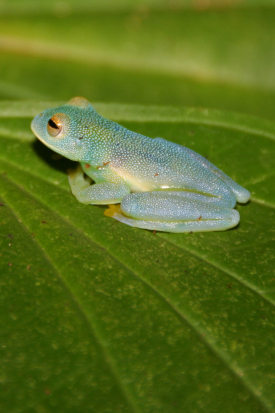
Another glass frog, Cochranella granulosa, found in Manuel Antonio National Park in Costa Rica. (Photo: JurriaanH, Wikimedia Commons, CC BY-SA 3.0)
The scientists were able to observe the hidden blood cells by using a technique called photoacoustic imaging, which showed the interior of the frogs’ livers by using subtle vibrations created by light striking various molecules and causing slight energy releases.
Some vertebrates are even more transparent than glass frogs. Larval stages of some fish, such as tarpon, eels, glassfishes, and Asian glass catfish, are almost perfectly transparent.
But having a transparent body on land or sea can have clear advantages.
That’s this week’s note on emerging science. I’m Don Lyman.
Related link:
Read the study on glass frogs’ blood
[SCIENCE NOTE THEME]
ANNOUNCER: Support for Living on Earth comes from Sailors for the Sea and Oceana. Helping boaters race clean, sail green and protect the seas they love. More information @sailorsforthesea.org.
[CUTAWAY MUSIC: Mason Williams and Deborah Henson-Conant, “Classical Gas,” live at John G. Shedd Institute for the Arts, Eugene, Oregon, by Mason Williams, Youtube/Billy Smith post]
The UAE Boosts Climate Pledge
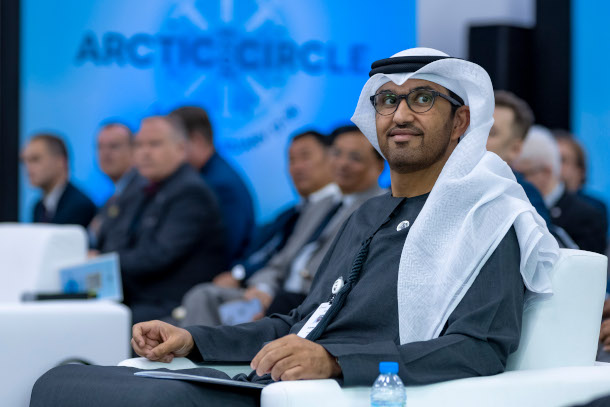
Sultan Al Jaber, the chief executive of the UAE's Abu Dhabi National Oil Company and president of this year's Cop28 UN climate summit. (Photo: Arctic Circle, Flickr, CC BY 2.0)
CURWOOD: It’s Living on Earth, I’m Steve Curwood.
O’NEILL: And I’m Aynsley O’Neill.
Amid controversy the United Arab Emirates is hosting this year’s United Nations climate negotiations known as COP28. And in answer to criticism the UAE’s Ministry of Climate Change and Environment recently said the country plans to cut emissions by 40% from business-as-usual by 2030. The UAE had earlier pledged a 31% reduction, but increased its commitment after an uproar over the designstion of the top executive of the UAE’s national oil and gas company to lead COP28. The research consortium Climate Action Tracker casts doubt on the UAE to meet its climate targets if it sticks with plans to boost oil and gas production. One of the critics of the UAE climate policy and its role in COP28 is David Tong, the Global Industry Campaign Manager for Oil Change International, who joins us from Wellington, New Zealand. David, welcome to Living on Earth!
TONG: Hi, Aynsley, nice to meet you.
O'NEILL: Now, the UAE has faced a lot of criticism after appointing Ahmed Al Jaber, as the President designate, for the upcoming COP 28 talks. He's the CEO of the Abu Dhabi national oil company. Can you tell us a little bit more about that?
TONG: Yeah. So every year the UN Climate Negotiations are presided over by a senior diplomat from the host country. This year, the UAE has appointed Sultan Al-Jaber as the president designate, he'll become the president at the start of the negotiations this November. And for the first time a country has appointed someone who is not just an employee of oil or involved in, but is the CEO of an oil gas company at NOC the Abu Dhabi National Oil Corporation. They are on track to be the second largest expander in terms of companies with the most expansion in new oil and gas from this year until 2025. So it's really concerning to have him presiding over the UN's crucial climate change negotiations. It's like putting the CEO of Philip Morris in charge of a conference on lung cancer.
O'NEILL: And the United Arab Emirates has just announced the change in its emissions target. Why did they change that now?
TONG: We can't say exactly why the UAE made that change now, it's a question they'd have to answer. But what we can say is what it looks like. And what it looks like is a presidency a country under intense pressure given their extraordinary conflict of interest, that is trying to salvage their credibility by framing themselves as a climate leader, without actually taking meaningful action to achieve this.

UN Secretary-General António Guterres at the fortieth anniversary of the Vienna International Centre. UN Secretary-General António Guterres has urged countries to “progressively phase out fossil fuels, moving to leave oil, gas and coal in the ground where they belong”. (Photo: IAEA, Flickr, CC BY 2.0)
O'NEILL: And from what you're seeing what sort of domestic policies are they planning to put in place in order to reach these targets?
TONG: The domestic policies that the UAE is putting in place have not changed significantly with this new target, and they are grossly insignificant. They plan to do some positive things like phasing out coal. But on the other hand, they're all in on expanding the use of fossil gas, which is completely at odds with both their climate targets and with what the world needs for 1.5 degrees. Both the Intergovernmental Panel on Climate Change and the International Energy Agency have made it clear that there's no room for new oil and gas, if we are to achieve the objectives of the Paris Agreement and limit warming to 1.5. Where the UAE is hoping to massively expand their reliance on the gas they produce and the guests they export in their new climate pledge. This has been rated by independent experts at climate action tracker as insufficient at odds with Paris objective and consistent with warming the world by around three degrees.
O'NEILL: Now, if they're planning to continue this reliance on fossil fuels, how exactly are they going to keep on pace for these targets? How much of this has to do with carbon offsets and carbon credits?
TONG: The UAE has made it very clear that they see it necessary to phase out fossil fuel emissions and argue that that is somehow possible to do without phasing out fossil fuels. That is simply false. And the UAE is planning to do this is through claiming that they can use dangerous distractions like carbon capture and storage. They want to develop industrial processes to draw down carbon dioxide from the atmosphere and stored underground. However, no CCS scheme is cost effective, almost all deliver less than promised. And the only scheme under development currently in the UAE if it did all that it promises to do only drawdown less than 0.5% of the country's annual emissions. So they're hoping to distract us with these technological magic fixes that don't actually work and just serve as a smokescreen to allow for continued oil and gas production.
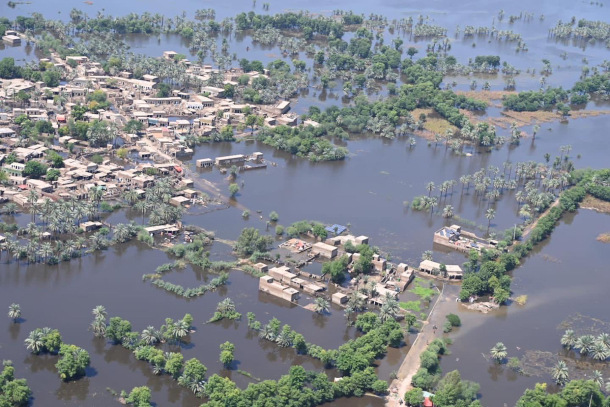
An aerial photo of flooded Sindh province in Pakistan in August 2022. Pakistan is a “poster child for impacts” from climate change, Alden Meyer says, since losses and damages from those floods could total $30 or $40 billion. (Photo: Ali Hyder Junejo, Flickr, CC BY 2.0)
O'NEILL: Now I want to take a step out and look a bit more globally. At the last climate talks COP 27 a loss and damage fund was established. That's a fund aimed at aiding vulnerable countries hit hard by climate disasters. What is the status of that project? And what hope is there that the project is going to be pushed forward during COP 28?
TONG: Last year was a breakthrough for loss and damage finance with the establishment of a loss and damage fund. That's the culmination of over 10 years of negotiations, and was a huge win for particularly at least developed countries and Africa and small island developing states especially in the Pacific. It was a breakthrough. And so there's a lot of expectations now for money to be put forward to go into that fund. That will be a critical test for COP 28 alongside the question of whether it delivers a comprehensive package to transform the world's energy systems.
O'NEILL: What does the UAE’s new carbon goal mean for the cop 28 process?
TONG: This may help to salvage some of the ways credibility with certain countries. And it may also send a political signal to encourage other countries to put forward new updated targets this year. But the real question is whether this COP delivers a comprehensive package for energy transformation, cutting to phase out fossil fuels, setting a target for renewable energy deployment and energy efficiency and providing safety measures to protect people and communities and finance to make this all possible. That's the real test and it's not clear that the UAE presidency is equipped to deliver this.
O'NEILL: David Tong is the Global Industry Campaign manager for Oil Change International. David, thank you so much for taking the time to join us today. T
TONG: Thanks Great to be here.
O’NEILL: In response to the Climate Action Tracker analysis the UAE's Ministry of Climate Change and Environment said "The UAE is fully committed to achieving its ambitious emission targets."
Related links:
- CNN | “Fake Twitter Profiles, Wikipedia Editing and PR Battles: Inside The Push To Greenwash The COP28 Climate Summit”
- Oil Change International | “COP28 President Declared That The “Phase Down of Fossil Fuels Is Inevitable””
- Reuters | “UAE Says It's Committed to Meet CO2 Emissions Targets After Criticism”
[MUSIC: Julian Lage, “Persian Rug” on Arclight, Mack Avenue Records II, LLC]
Europe Votes to Restore Nature

Austrian ecosystem researcher Andreas Böhner and several graduate student assistants monitor soil chemistry and plant growth in an alpine pasture within a protected area, where agriculture co-exists with nature conservation. (Photo: Bob Berwyn)
O’NEILL: Biodiversity across the world is in trouble. Scientists have warned that one million species of an estimated total of eight million are threatened with extinction, many within decades. So, in order to address the main drivers of biodiversity loss, the European Parliament has adopted a nature restoration plan. The goal is to ensure that 30% of EU territory consists of natural areas by 2030. This is part of the European Green Deal, approved in 2020, which is a set of policy initiatives by the European Commission with the aim to bring the EU into climate neutrality by 2050. The law now faces further refinement by the EU commission and the EU Council, where government representatives could come together and agree on the law’s final form as soon as December. Here to talk about the European Union measure to protect biodiversity is Inside Climate News reporter Bob Berwyn. He joins us now from Austria. Welcome to Living on Earth Bob!
BERWYN: Thanks for having me.
O'NEILL: We're talking about an area that spans more than 4 million square kilometers. How badly have these affected natural areas? You know, forests, wetlands, lakes, how badly have they been degraded?
BERWYN: The EU itself estimates that about 80% of its natural areas are not in good shape. So there's a lot of need for restoration. Forests are especially hard hit, rivers through diversions and through pollution, ocean areas, the Mediterranean coastal Atlantic from marine heat waves that have just decimated marine life. There have been multiple mass mortality events from marine heat waves in the Mediterranean.
O'NEILL: And Bob, you're a science reporter. So can you tell us about some of the science behind this? What is some of the science behind protecting wetlands, for example?
Climate activist Greta Thunberg joined a demonstration outside the EU Parliament to call on lawmakers to back a flagship nature restoration law pic.twitter.com/DC1dggvLRN
— Reuters (@Reuters) July 11, 2023
BERWYN: Right, I'll give a little big picture background first, and that is that major global science reports in the last few years, such as from the IPCC, the Intergovernmental Panel on Climate Change, have all said that repairing these damaged ecosystems is really key to ensuring a sustainable, livable planet, and also to slowing down global warming and addressing climate change, specifically to wetlands. And this holds true not just for Europe, but many areas globally, North America, the US also many, many wetland areas were drained during settlement and colonialization for agricultural areas, because they overlap with that. And some are are not needed as much as they were because we've intensified agriculture. So some are just sitting there and many could be restored rewetted and would serve multiple purposes. And there's a lot of peer reviewed scientific studies showing that if you re-water X amount of wetlands, they absorb that much more carbon it's a measurable benefit. And restoring wetlands has other benefits as well, too. It's just hugely critical for wildlife habitat. So you get the benefits of having habitat for insects and reptiles, amphibians, which are threatened, and then in turn birds and so forth. And healthy wetlands also help attenuate floods and help sort of act as sponges if there's extreme rainfall, which is happening a lot with climate, and they can absorb the water as a sponge when it runs down. And then they release it more slowly and keep streams flowing through through drier times.
O'NEILL: And we mentioned the Mediterranean Sea, hammered by marine heatwaves, mass mortality events, how do we go about restoring that area?

A group of Austrian farmers and forest owners tour an Alpine wilderness forest that could someday be expanded under the EU’s new nature restoration law. They were there to learn about the ecological benefits of expanding areas where natural processes prevail. (Photo: Bob Berwyn)
BERWYN: So within an area like the Mediterranean, which is a good example, because it's an enclosed sea, you know, there are pockets of good habitat, there are places where the waters deeper, there are places where some species are going to be able to persist. If you can protect those and ensure that there are good habitat conditions for the fish in those areas, perhaps they'll be able to survive, you know, another 50 years until we've kind of leveled off the global warming graph. And you know, a great example that comes to mind are seagrass beds that also have multiple benefits, sort of like wetlands, they're really important for sea turtles and they need to be in the right places. And they also absorb a lot of carbon. So there's a lot of efforts right now being aimed at trying to protect what seagrass beds remain, a lot of them were damaged by fishing. Some are losing ground, also because of global warming. And there's probably not too much that can be done about that. But the ones that can be protected should be.
O'NEILL: And I mean, we've been talking up all the benefits of this law, but as there always are, there are some naysayers. There are some opponents who opposes this law and what is their reasoning behind it.

The Imielty Ług nature reserve in Poland consists of ponds that cover a total of more than 2,000 hectares (4,900 acres) and wetlands that lead to open water. The EU nature law seeks to restore and protect natural areas like the Imielty Ług nature reserve. (Photo: Lysy, Wikimedia Commons, CC BY-SA 3.0)
BERWYN: So the vote on the law was pretty close and the European Parliament is big, and it's rowdy, and it has a whole bunch of different groupings, and it was opposed by a coalition of center right, all the way to the right wing parties for a variety of reasons. Some of the bigger main conservative parties opposed it supposedly on behalf of agricultural interests. The claims made by conservation advocates who back the law say that those parties are influenced by the same lobbyists that influence politics everywhere else fossil fuel companies who produce pesticides who produce artificial fertilizers, big agribusinesses, international grain companies and food producers who don't think they have anything to gain from more sustainable food production. Certainly there were farmers and you know, there visible, you can see pictures of tractors farmers driving their tractors to protest. It wasn't always clear from talking to them, or from seeing interviews with them, that they really understood the law itself. I think in a lot of cases, there was a bit of a scare campaign organized to create the perception of a threat to food supply, but all those arguments were made without any sort of scientific support. On the other hand, the European Union has produced multiple studies their own environmental agency showing how if you start to use more regenerative farming practices and start restoring the soil, you're actually going to get benefits from that in terms of food productivity. And if you protect insect biodiversity, which is crucial to agriculture, you're going to have better agriculture as well. It's not really about nature, some of the main proponents have said this. It's about us, we can't exist without healthy nature. We can't we can keep borrowing from nature's piggy bank, so to say, but it's going to be empty at some point. Yeah, nature is amazing, it has the capacity to really heal itself and relatively quickly but we're hammering it and it's time to reverse that.
O'NEILL: Bob Berwyn is a science reporter for InsideClimate News. Bob, thank you for joining us today.
BERWYN: My pleasure. Thanks very much for having me, it was great to be able to talk about this important law.
Related links:
- Inside Climate News “European Union Approves Ambitious Nature Restoration Law”
- Learn more about the EU nature restoration law
[MUSIC: Daniel Hayn, Paul Grant, Jonny Tobin, “On the Fly” Single, Radio Juicy]
Slip-Sliding Away
A river otter pokes his head out of the water. (Photo: Mark Seth Lender)
CURWOOD: River otters are a rather elusive creature, as they typically avoid human contact. The best way to find them is to wait for them to find you, as Living on Earth’s Explorer in Residence, Mark Seth Lender discovered on Martha’s Vineyard in Massachusetts.
LENDER: On the far side of the pond bubbles braille the surface, cerulean blue, soft as morning stars.
Half Light.
The air is still.
The lilies rustle, their posted buds stirred by a breeze of water sway like channel markers.
There.
Just off shore.
Someone breaking fast. Leisurely. Jaws worked in a whisper reaching across the silence there.
Then rolls. And dips. And gone.
A beaver lodge stands nearby. They built this pond but that was no beaver. The texture of his fur, the shape and the way he moved. The smoothness of the dive and how the surface rose and closed, a navel of water; and what it brings to mind.
That surface, opaque as skin, blind to what lies beneath:
Patience… Patience…
The crease of a wake.
No sound.
A head appears -
Oiled. Sleek. Coat as silky as a Tonkinese all umber and burnt ochre. Whiskers. Dark eyes. Fearless. That broad Boy Cat face so close –
River otter!
And my heart leaps. And every hair stands. I too am fearless I am soaring I see what I was sure I would never see again...
River otters tend to shy away from humans. (Photo: Mark Seth Lender)
June 3rd, 1984:
We are making our way down to Herring Creek where the water rushes through the narrows on the changing of the tide, Squibnocket Pond pouring into Menemsha, the herring swimming in place in the current made by the flow. Across the waterway snowy egrets, bronzed by the ending of the day are gathering in the tall trees for sleep; Black-crowned night herons roost in the scrub below, restless to begin their night of hunting. We’d just met, Valerie and me, our first time together longer than a cup of coffee.
“Goldfinch,” I point him out. The bright yellow trace in his free and unpredictable flight. The cry of osprey; kingfisher hovering; mute swans in V formation and the whistling of their wings.
And then -
Round the corner of the creek one-two-three-four river otters in slipstream swimming towards us. Ignoring our presence they come, only feet from where we stand, chasing the herring for the pure pleasure of it, catching none, the fish swirling in a terror, the otters circling and circling and their mother’s wallering call like the laughter a walrus might make, so guttural and deep in the throat for the size of her.
And my heart is pounding, my hands shake, and all I can say is, “You’ll never see this again, this is once in a lifetime, you’ll never see this again…”
And here, again.
Otter having had his long look turns away. Now the sleek head now the long back now the thickness of his tail slipping beneath. And reappears. And looks again dives again, resurfaces, This time with a bullfrog in his mouth. It dangles as if forgot, his gaze fixed on me. And then and for the last time slides below leaving a silence so profound neither speech nor written word can break it. The only river otter in the quarter century from then, till now.
Valerie claims she knew she would marry me when she saw me, in my new plaid shirt, leaning against the doorway watching her from across the room. But I know it was among river otters, as if we were the reason for their coming and lingering, in perfect confluence with the arc of our lives to come.
Will I mark the otter as Meton marked the cycle of the moon, a slow and infinite repeating over time? Or will it fade.
Be brave.
CUROOD: That’s Living on Earth’s Explorer in Residence, Mark Seth Lender. For photos, swim on over to the Living on Earth website, LOE dot org.
Related link:
Visit Mark Seth Lender’s website
[MUSIC: Jacky Terrasson, “Mo Better Blues” on Smile, Blue Note Records]
O’NEILL: Coming up, the biodiversity risks of mining for rare minerals on the deep ocean floor. Stay tuned to Living on Earth.
ANNOUNCER: Support for Living on Earth comes from Friends of Smeagull the Seagull and Smeagull’s Guide to Wildlife. It’s all about the wildlife right next door to you! That’s Smeagull, S - M - E - A - G - U - L - L, SmeagullGuide.org.
[CUTAWAY MUSIC: The Marcus Roberts Trio, “Nothin’ Like It” on In Honor Of Duke, Sony BMG Music Entertainment]
BIRIDNOTE®: Bird Habitat at Home
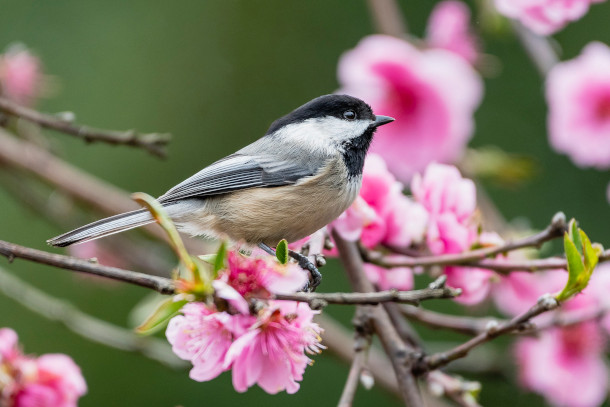
A black-capped chickadee perches on a tree branch. (Photo: Colin Durfee, CC)
CURWOOD: It’s Living on Earth, I’m Steve Curwood.
O’NEILL: And I’m Aynsley O’Neill.
[BIRDNOTE THEME]
O’NEILL: One way to help combat biodiversity loss in your own backyard is to cultivate the kind of natural habitat that backyard feeder birds can make into a home. BirdNote’s Ariana Remmel has the story.
BirdNote®
Creating Bird Habitat at Home
One of the biggest threats to birds is the decline in biodiversity due to habitat loss — and the traditional, manicured lawn isn’t helping.
[Black-capped Chickadee call, ML 202239]
Even birds who visit backyard feeders — like these Black-capped Chickadees — need a healthy mix of seeds, berries, and insects often found on the native plants we villainize as “weeds” when they grow in our lawns, says ecologist Douglas Tallamy.
Doug Tallamy: We have more than 40 million acres of lawn in the US, which is the size of New England. And that's an ecological deadscape.
[Deciduous Forest Morning Songbirds]
That means one of the easiest ways to protect birds at home is to grow native plants, says Tallamy, who co-founded an organization called Homegrown National Park® to help people transform their lawns into havens for wildlife.
Doug Tallamy: And I’d love people to stop looking at their yard as an isolated ecosystem, it's part of a neighborhood. And somebody who's got a sunny spot down the street, but no trees? Okay, that's where the pollinator gardens go. Somebody who's got a giant oak and is overspreading two or three yards? That's great! That's going to provide a lot of resources for many of the houses in that yard. So look at your neighborhood as an entire local ecosystem and see what the total resources are.

A black-capped chickadee bites down on a seed. (Photo: Tom Murray, CC)
Reducing your lawn to make room for native plants is a small step forward —
Doug Tallamy: But imagine if everybody did this. This is why we call the Homegrown National Park® movement a grassroots movement, it's a call to action.
To learn more about Homegrown National Park®, start at our website: BirdNote dot org.
[Black-capped Chickadee call, ML 202239]
###
Written by Ariana Remmel
Senior Producer: John Kessler
Content Director: Allison Wilson
Producer: Mark Bramhill
Managing Producer: Conor Gearin
Bird sounds provided by The Macaulay Library of Natural Sounds at the Cornell Lab of Ornithology, Ithaca, New York. Black-capped Chickadee ML 202239 recorded by J. McGowan. Morning Songbirds recorded by Gordon Hempton.
BirdNote’s theme was composed and played by Nancy Rumbel and John Kessler.
© 2022 BirdNote March 2022 Narrator: Ariana Remmel
ID # hnp-01-2022-03-21 hnp-01
https://www.birdnote.org/listen/shows/creating-bird-habitat-home
Related link:
Learn more on the BirdNote® webpage
[MUSIC: Julian Lage & Chris Eldridge, “Greener Grass” on Mount Royal, Free Dirt Records]
Mining Riches on the Ocean Floor
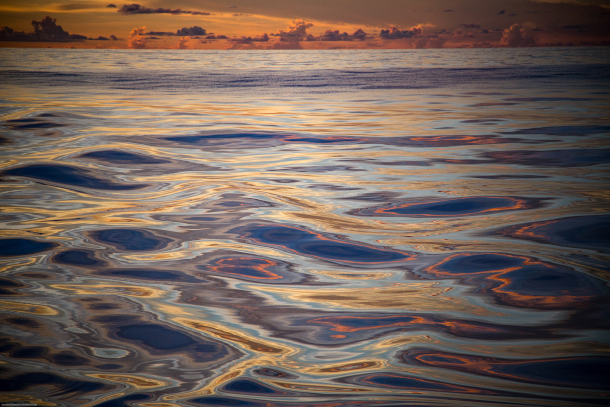
The Clarion-Clipperton Zone stretches from southeast of Hawaii all the way to Mexico, averaging a depth of three miles. (Photo: NOAA Office of Ocean Exploration and Research, Deepwater Wonders of Wake, public domain)
CURWOOD: Parts of the deepest oceans are carpeted with manganese nodules that also contain many other valuable minerals, and for decades the allure of mining riches has colored international efforts to protect the seas. Technological challenges and various procedural provisions linked to 1982 Law of the Sea Treaty have prevented exploitation of the seabed metals so far, but now a time limit has expired for a defacto mining moratorium under the treaty’s International Seabed Authority. In 2021 the Pacific Island nation of Nauru applied for a mining permit on behalf of a Canadian company, a move that gave the Seabed Authority two years to make any seabed mining rules it would enforce. But in July that deadline came and went, and the seabed authority has asked for more time. So far, the company is waiting for rules and not moving ahead to begin mining. The manganese nodules could be extremely useful for metals needed for renewable energy resources. At the same time the largely unexplored deep ocean is seen by scientists as a vulnerable hot spot of diversity that could be hurt by mining. Here to tell us more is Professor Eugene Gallagher at the University of Massachusetts Boston. Welcome to Living on Earth, Dr. Gallagher!
GALLAGHER: Good to be here.
CURWOOD: Now please describe for us, professor, what is the Clarion-Clipperton Fracture Zone, and talk to me about the ecosystem, what's it like there?
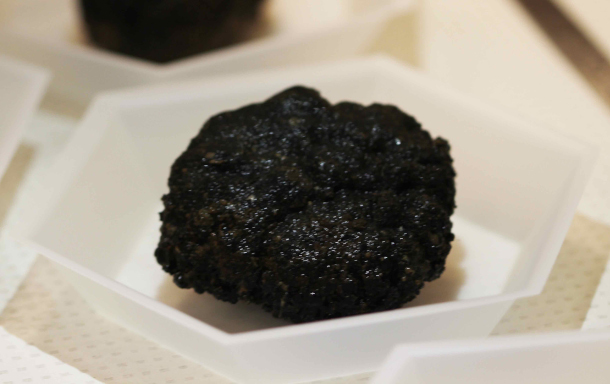
Manganese nodules, found in the Clarion-Clipperton Zone, take millions of years to form and contain coveted metals like cobalt. (Photo: DeepCCZ expedition, NOAA, public domain)
GALLAGHER: Yeah, the Clarion-Clipperton Zone is huge. It's a zone located between the southeast of Hawaii stretching all the way to Mexico. If you were to draw a line from California all the way to Georgia, it's equivalent to the whole southern part of the United States. The depth is on average about three miles deep, and it has the highest concentration of manganese nodules of any area in the world's ocean. And these are objects about the size of small potatoes, some of them as large as an Idaho potato. The nodules are so dense in some areas that they look like a New Bedford cobblestone road. They pave the deep sea. And the animals that live there, most of them are small. And one of the surprises in benthic ecology is that the abyssal plains, people thought that virtually nothing could live there. But then in 1967, two Woods Hole Oceanographic scientists, Hessler and Sanders, discovered that the species diversity is very high in the abyss. Much higher than what you would get in the Gulf of Maine or on the continental shelf. And the species richness in the Clarion-Clipperton Zone is about the highest of any abyssal area, you know, in the world's oceans. It has very little food input. So although the number of species is large, the abundance of animals is quite small. So in a quarter meter squared box core, in Massachusetts Bay, we would get 20,000 animals. In the Clarion-Clipperton Zone, you would find fewer than 100 individuals, but of those 100 individuals, you may have 70 species. So it's low abundance, but incredibly high species richness.
CURWOOD: So why are people in the international community so interested in mining in this area? This has been going on for years, I think back in the 70s, Howard Hughes was trying to build machines to get down there to get the nodules. What's the attraction of these nodules?
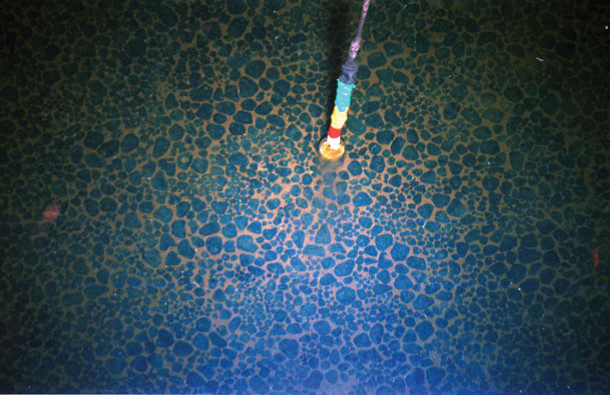
In some parts of the Clarion-Clipperton Zone, manganese nodules are so abundant that they “pave” the seafloor. (Photo: USGS.gov; Article by Hein, et al., 2015, Ore Geology Reviews; photo taken during a research cruise in 2000, public domain)
GALLAGHER: Yeah, things have changed a little bit. Back in the 1970s, when there were several US companies planning to mine the Clarion-Clipperton Zone, you know, the big issue was getting nickel. But now in the age of global warming, there is a huge effort to increase the number of rechargeable batteries, to increase the number of solar panels and to increase the number of wind turbines. And all of those require high concentrations of manganese, nickel, cobalt, especially. Cobalt is crucial for rechargeable batteries. If we want to meet our needs for rechargeable batteries, particularly in automobiles and trucks, the supply of cobalt is going to get critically scarce within a decade. And then there are rare earth elements, tellerium and neodymium, the key element needed for wind turbines. And one wind turbine will require 4,000 pounds of neodymium in order to run. And so all of these metals are scarce in terrestrial supplies. And largely the cobalt is under the control of the People's Republic of China. But they are abundant in the Clarion-Clipperton Fracture Zone manganese nodules. The supply of cobalt in the Clarion-Clipperton Fracture Zone is something like 40 times the entire terrestrial supply of cobalt.
CURWOOD: So, if mining companies do get access down there in the deep sea, what are some of the potential consequences of the mining activity? Why are scientists and other stakeholders sounding the alarm about this prospect?
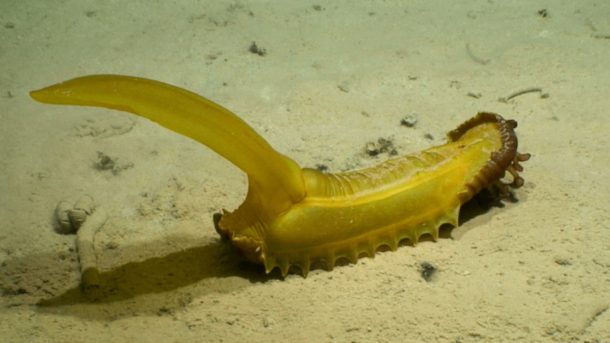
Some scientists are concerned that mining activity will wipe out the diverse species that live in the CCZ, like the Psychropotes longicauda, nicknamed the “Gummy Squirrel.” (Photo: DeepCCZ expedition, NOAA, public domain)
GALLAGHER: The area has a really low sedimentation rate. So there's only about a millimeter to three millimeters per 1000 years. And these collecting devices, which they have different technologies, but one of them is essentially vacuum cleaning up the nodules from the surface of the Clarion-Clipperton Zone. First of all, they're going to wipe out the nodules and all of the associated fauna. And the nodules take anywhere from 1 million to 10 million years to grow. So they are not a sustainable resource by any means. They're going to be gone and all of the animals associated with them will be gone. But then the big worry is that it's going to resuspend sediment that may wipe out a much larger area than the area being mined. And some estimates would have it that it's going to wipe out an area anywhere between three and ten times the area that is being mined. And we simply don't know how well many of the animals adapted for one millimeter per thousand year sedimentation are going to be able to tolerate one to three millimeter per year sedimentation from active mining.
CURWOOD: You've studied these regions, this ecology, literally for decades. In your opinion. To what extent should we be looking to mine these resources, or should we be just simply saying, guess what, we need to leave this alone?
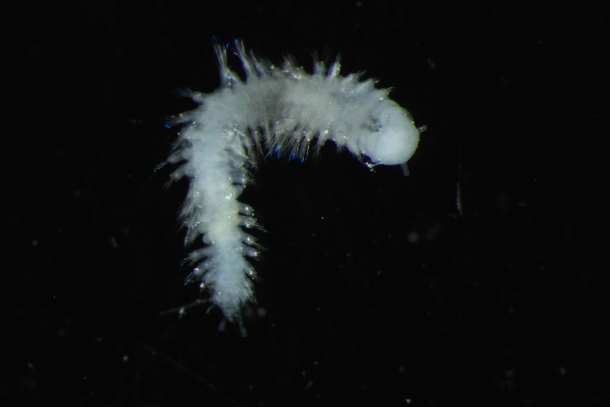
Many of the species in the CCZ were recently discovered, like this new species of worm still awaiting its official name. (Photo: NOAA DeepCCZ Partners: University of Hawaii (US), Natural History Museum (UK) and University of Gothenburg (Sweden))
GALLAGHER: There are marine biologists that have made the case that we should not mine these areas at all, that they are all hotspots of biodiversity in the abyss. They're not only high species richness, but also, we don't know how unique the fauna is in each area. But on the other hand, we desperately need to control the increase in atmospheric CO2 concentrations. And the major ways for doing that are electric batteries, wind power, and solar power. And all three of those require heavy metals. So as a compromise, many deep sea scientists have mapped out a plan where there might be a 10 year moratorium on mining so that we can do additional work, especially in one area. And that is to increase the distribution and the type of areas that are called APEIs, Area of Particular Environmental Interest. And these are like wilderness preserves that we have in the United States. These are areas that will not be mined. But some of the research that's been done on these areas indicate that it doesn't represent the true variety of habitat types in the Clarion-Clipperton Zone, and that we need more of them. And certainly, we need to to study them more to find out whether they are indeed going to act as refuge, as wilderness areas, to preserve the diversity of this large region of the deep sea.
CURWOOD: What's the middle ground on this issue?
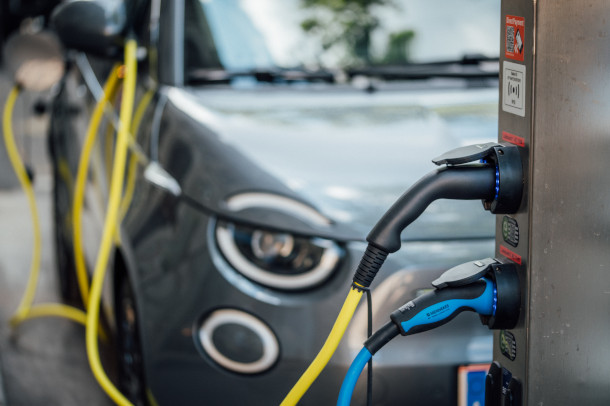
Cobalt, found in manganese nodules, plays a critical role in electric cars’ rechargeable batteries. (Photo: Ivan Radic, Flickr, CC BY 2.0)
GALLAGHER: Yeah, there are, several things have been advocated. We need the metals right now. And so one of the solutions is to develop what's called a circular economy, to develop the technology to recycle metals. And people have done analyses of that. And the unfortunate thing is, in the next 20 to 30 years, we're going to be building up, you know, huge numbers of vehicles and wind turbines and solar panels, and there's going to be very little material to recycle. The other huge option is to have the chemists come up with a different technology for batteries, and for magnets and solar panels that don't require the heavy metals. And in particular, there have been some advances to reduce the amount of cobalt required in rechargeable batteries. You know, there are 20 pounds of cobalt in a typical car battery. And these new batteries that are being developed for large pickups have hundreds of pounds of cobalt for the cathodes and their rechargeable batteries. You know, if they come up with a new chemical system for developing charging new batteries to eliminate the need for so much cobalt, that would be a huge benefit. But cobalt turns out to be the really critical metal. It's going to be in such scarce supply with so little material available from recycling, and the technologies haven't been developed to replace cobalt, that within 10 to 20 years, there will be a desperate need for cobalt in the world if we're going to reduce atmospheric CO2concentrations.
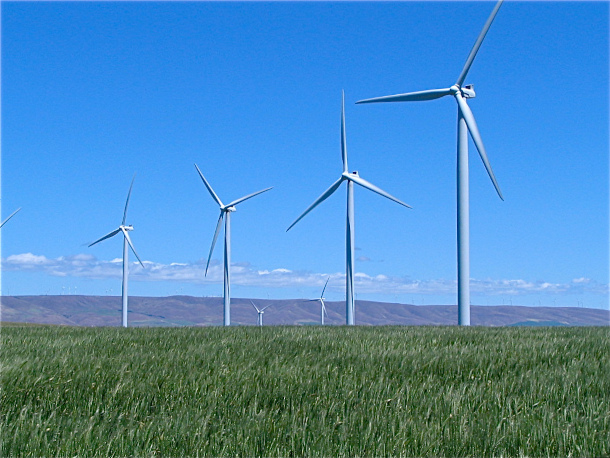
One wind turbine can require up to 4,000 pounds of neodymium, one of the rare earth elements found in manganese nodules. (Photo: Shawn Meng, Oregon Department of Agriculture, Flickr, CC BY-NC-ND 2.0)
CURWOOD: Before we go, share your outlook on this, you as a scientist, concerned about the environment, concerned about the biological diversity there. How optimistic are you that this will get resolved in a way that works for people and nature?
GALLAGHER: Well, the thing that concerns me most is that we may not know what the effects are. You know, this is an area that is vast. I was doing the back of the envelope calculation, and you've got an area about the size of the southern part of the entire United States. And the entire area that has been quantitatively sampled, with the species identified, would fit in a one quarter of a basketball court. It's just a tiny area. And one of the tragedies in this is, we would have had many of the answers, except the United States completely eliminated its budget for assessing the environmental effects of deep sea manganese nodule mining. They had a program starting in the 1970s through 1994, called DOMES, the Deep Ocean Mining Environmental Studies. And it was completely zeroed out. And the tragedy of that is, is that when you're analyzing the samples from this area, it takes the world's best taxonomists, you know, when 60% of the species are represented by single individuals and most of those are new to science. It requires the world's best taxonomists, and they all, they all lost their funding. It's very difficult in the United States to even find the scientists who are able to identify the species in the Clarion-Clipperton Zone. And it's a real tragedy, that we'll be going ahead with the mining and we won't know the effects and we won't have the ability to determine the effects of the mining.
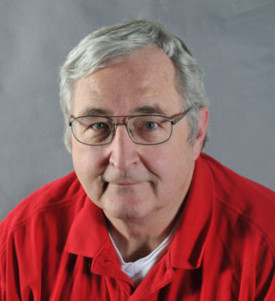
Eugene Gallagher is an Associate Professor of Benthic Ecology and Statistics at the University of Massachusetts Boston School for the Environment. (Photo: Courtesy of Eugene Gallagher)
CURWOOD: Eugene Gallagher is a professor of benthic ecology and statistics at the University of Massachusetts Boston. Gene, thanks so much for taking the time with us today.
GALLAGHER: Well, thank you.
CLARIFICATION: Nauru sent a letter of intent in 2021 that triggered the rule making deadline, but to date has not filed a full application.
Related links:
- International Seabed Authority | “Home Page”
- International Seabed Authority | “Clarion Clipperton Fracture Zone: Exploration Area”
- Smithsonian Magazine | “These Mysterious Deep Sea Creatures Live in a Potential Mining Zone”
- NOAA | “Deep CCZ”
- NOAA | “Deep CCZ Mining Interests in the Clarion-Clipperton Zone”
[MUSIC: Soulive, “Doin’ Something” on Doin’ Something, Blue Note Records]
O’NEILL: On the next Living on Earth How Jellyfish Age Backwards: Nature’s Secret to Longevity.
BRENDBORG: My book title refers to a type of jellyfish called Turritopsis, which is this tiny jellyfish around the size of a fingernail, it has the ability to actually rejuvenate itself. So what actually happens is that you stress it somehow, for instance, by increasing the temperature in the water or increasing the salinity, or maybe starving the jellyfish a little. And then it can go from what is called the adult stage, so the stage that we know it from, back to something called the polyp stage. That would be akin to a butterfly turning back into a caterpillar. Then from there, the jellyfish can grow up anew, and then it can just go around in this cycle again and again and again. Of course, this jellyfish doesn't live forever out in nature where it lives in this big, big ocean, here it's gonna get eaten by something eventually. But at least in the laboratory no one has actually found a limit to how much you can make this jellyfish rejuvenate itself. So, it's quite possible that as long as it had scientists to take care of it, you could actually make it live forever. So, in principle, you can say it's an example of the holy grail of aging research, so that is an animal that can practically live forever, at least under human protection.
O’NEILL: Tune in next week for more!
[MUSIC: Soulive, “Doin’ Something” on Doin’ Something, Blue Note Records]
CURWOOD: Living on Earth is produced by the World Media Foundation. Our crew includes Naomi Arenberg, Paloma Beltran, Josh Croom, Jenni Doering, Swayam Gagneja, Madison Goldberg, Mark Kausch, Mark Seth Lender, Don Lyman, Sarah Mahaney, Sophia Pandelidis, Jake Rego, Clare Shanahan, El Wilson, and Jolanda Omari.
O’NEILL: Tom Tiger engineered our show. Alison Lirish Dean composed our themes. You can hear us anytime at L-O-E dot org, Apple Podcasts and Google Podcasts, and like us, please, on our Facebook page - Living on Earth. We tweet from @livingonearth. And find us on Instagram at livingonearthradio. And you can write to us at comments at loe dot org. I’m Aynsley O’Neill.
CURWOOD: And I’m Steve Curwood. Thanks for listening!
ANNOUNCER: Funding for Living on Earth comes from you, our listeners, and from the University of Massachusetts, Boston, in association with its School for the Environment, developing the next generation of environmental leaders. And from the Grantham Foundation for the protection of the environment, supporting strategic communications and collaboration in solving the world’s most pressing environmental problems.
ANNOUNCER 2: PRX.
Living on Earth wants to hear from you!
Living on Earth
62 Calef Highway, Suite 212
Lee, NH 03861
Telephone: 617-287-4121
E-mail: comments@loe.org
Newsletter [Click here]
Donate to Living on Earth!
Living on Earth is an independent media program and relies entirely on contributions from listeners and institutions supporting public service. Please donate now to preserve an independent environmental voice.
NewsletterLiving on Earth offers a weekly delivery of the show's rundown to your mailbox. Sign up for our newsletter today!
 Sailors For The Sea: Be the change you want to sea.
Sailors For The Sea: Be the change you want to sea.
 The Grantham Foundation for the Protection of the Environment: Committed to protecting and improving the health of the global environment.
The Grantham Foundation for the Protection of the Environment: Committed to protecting and improving the health of the global environment.
 Contribute to Living on Earth and receive, as our gift to you, an archival print of one of Mark Seth Lender's extraordinary wildlife photographs. Follow the link to see Mark's current collection of photographs.
Contribute to Living on Earth and receive, as our gift to you, an archival print of one of Mark Seth Lender's extraordinary wildlife photographs. Follow the link to see Mark's current collection of photographs.
 Buy a signed copy of Mark Seth Lender's book Smeagull the Seagull & support Living on Earth
Buy a signed copy of Mark Seth Lender's book Smeagull the Seagull & support Living on Earth

